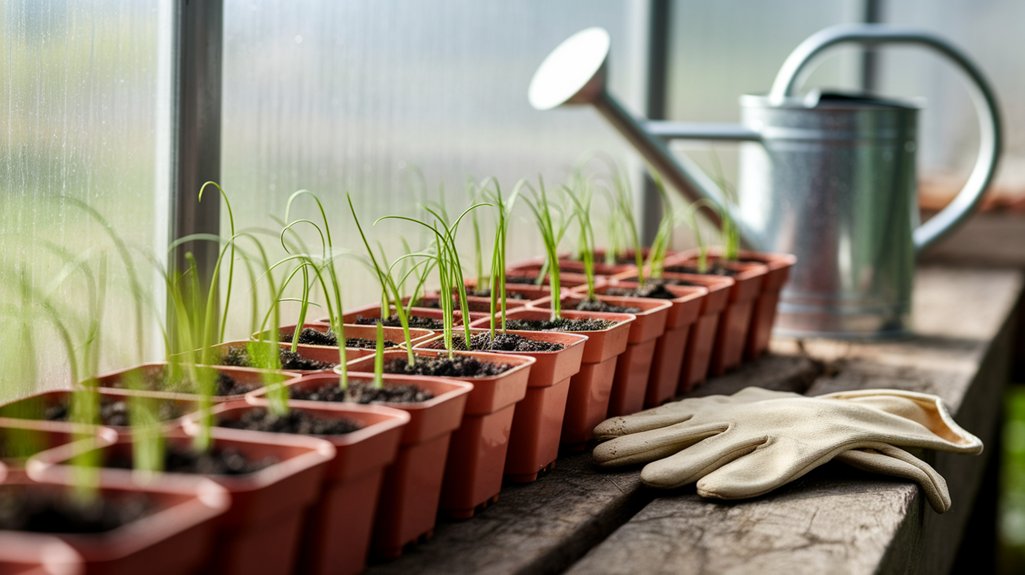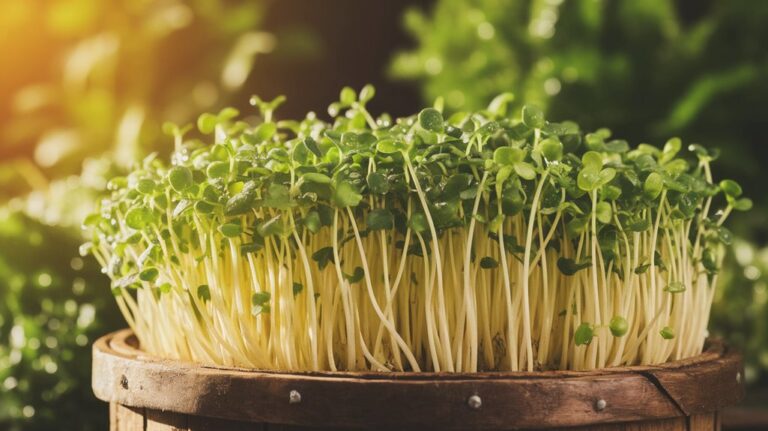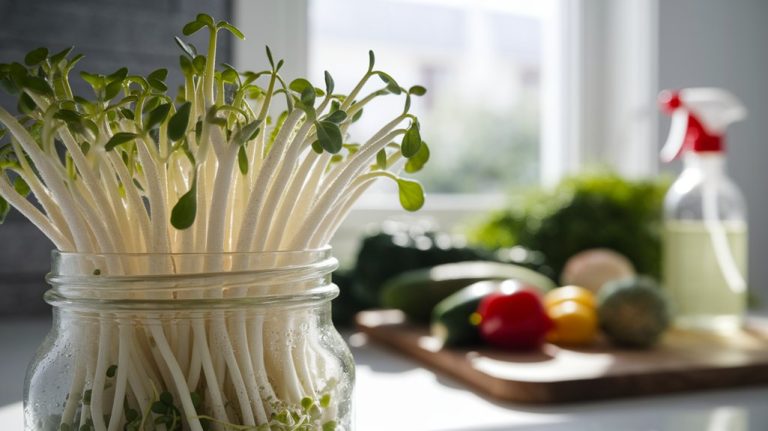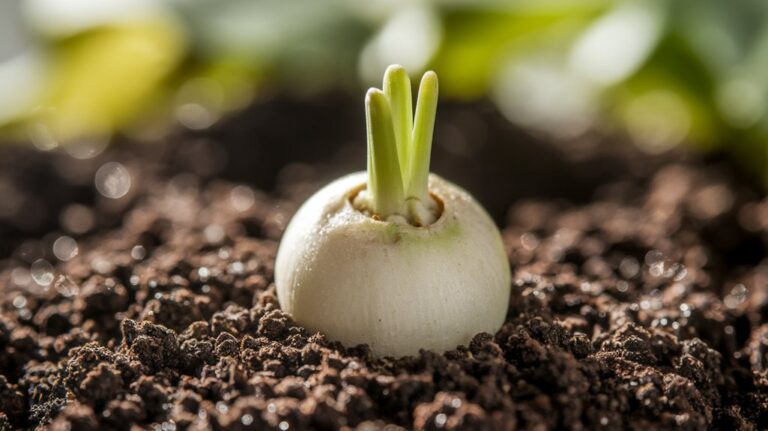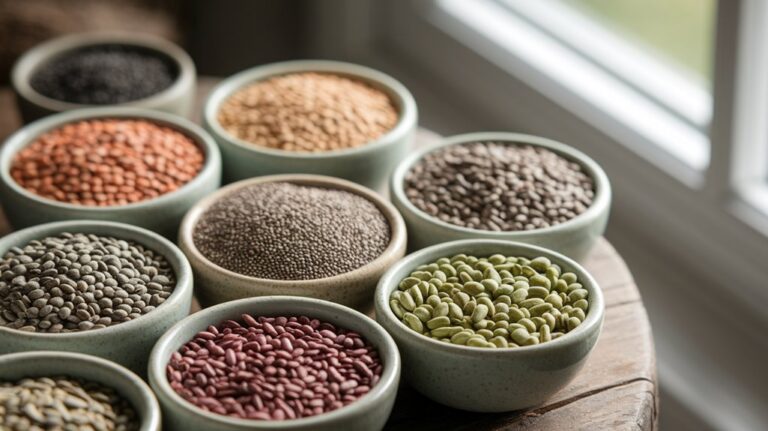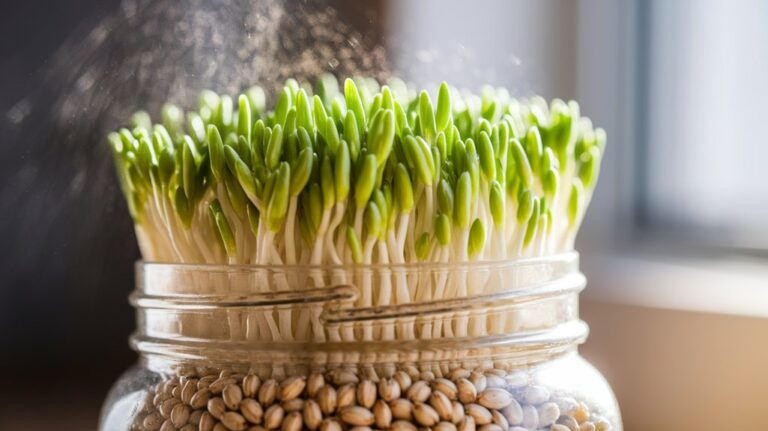How to Sprout Spigarello
To sprout spigarello, I start by selecting high-quality seeds, preferably heirloom or open-pollinated varieties. Next, I prepare well-draining, nutrient-rich soil with a pH of 6.0 to 7.0, incorporating organic matter like compost. After ensuring the soil’s moisture is consistent, I sow the seeds at a depth of about 1/4 inch. In about 60 to 90 days, I can harvest vibrant green leaves. Interested in more tips on growing spigarello successfully?
Key Takeaways
- Select high-quality heirloom or open-pollinated spigarello seeds with high germination rates for successful sprouting.
- Prepare well-draining soil with a pH of 6.0 to 7.0, enriched with organic matter like compost.
- Sow seeds directly into the soil or start indoors 4-6 weeks before the last frost date for optimal growth.
- Keep the soil consistently moist but not waterlogged, ensuring adequate drainage for healthy sprouting.
- Provide at least six hours of sunlight daily to encourage strong seedling development as they sprout.
Understanding Spigarello: A Brief Overview
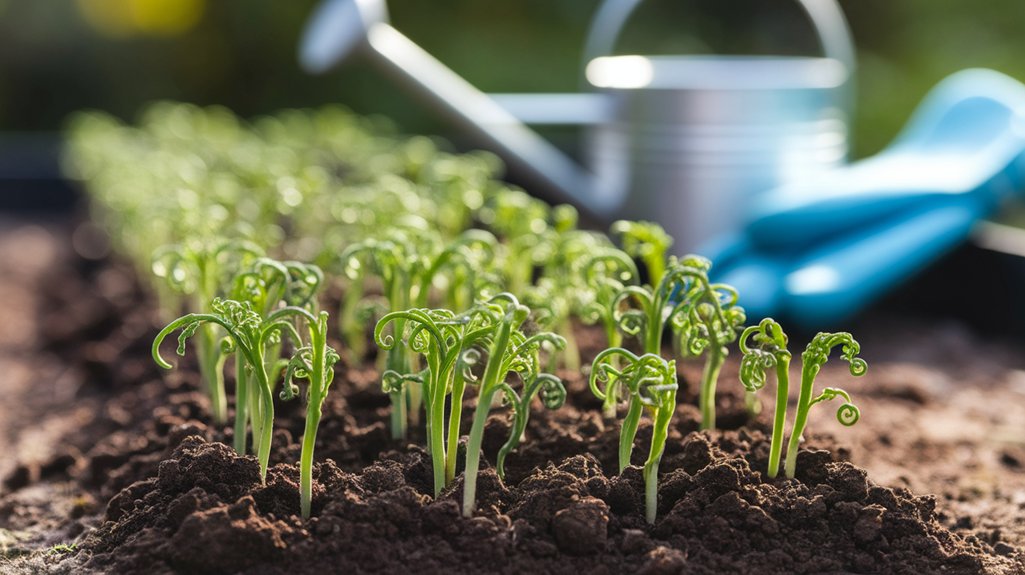
Spigarello, a leafy green vegetable from the Brassica family, is gaining popularity for its unique flavor and nutritional benefits.
I’ve found that it’s a versatile plant, often used in Italian cuisine, where its tender leaves offer a slightly sweet, earthy taste. Unlike traditional broccoli, spigarello doesn’t form heads; instead, it produces an abundance of lush leaves and small flowering shoots.
Nutritionally, it’s a powerhouse, rich in vitamins A, C, and K, along with essential minerals like calcium and iron. It’s also known for its high antioxidant content, which can help combat oxidative stress.
Growing spigarello is relatively straightforward, making it an excellent choice for both novice and experienced gardeners looking to diversify their vegetable options.
Choosing the Right Seeds for Spigarello
When starting your journey with spigarello, selecting the right seeds is vital for a successful harvest.
I’ve found that choosing high-quality seeds can make all the difference in flavor, yield, and resilience.
Here are three essential factors to consider:
- Seed Variety: Look for heirloom or open-pollinated varieties. They often have superior taste and adaptability.
- Germination Rate: Check the seed packet for germination rates. Higher rates mean more plants will sprout, giving you a better chance for a bountiful crop.
- Source: Purchase from reputable seed companies that prioritize organic practices. This ensures your seeds are healthy and free from harmful chemicals.
Investing time in these choices will lead to a thriving spigarello garden that you can be proud of!
Preparing Your Soil for Planting
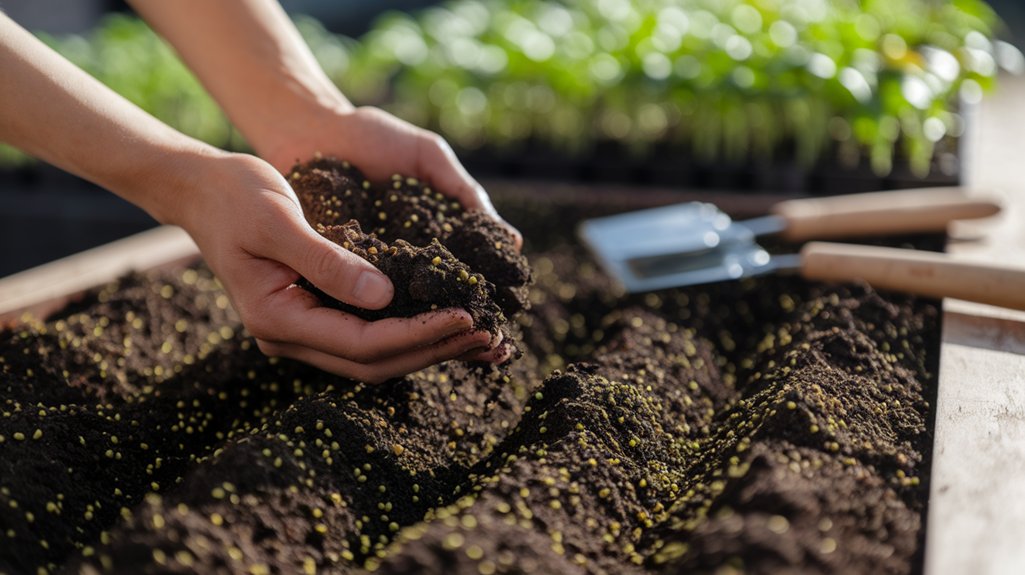
Before planting your spigarello seeds, it’s crucial to prepare your soil properly to ensure optimal growth.
Start by selecting a well-draining location with plenty of sunlight. I recommend testing the soil pH; spigarello thrives in slightly acidic to neutral soil (pH 6.0 to 7.0).
Amend the soil with organic matter like compost to enhance fertility. Tilling the top 12 inches is essential for aeration and root penetration.
Remove any rocks, weeds, or debris that could hinder growth. If your soil is heavy clay, consider mixing in sand or perlite to improve drainage.
Lastly, ensure the soil is moist but not soggy before planting. This preparation sets the stage for healthy spigarello seedlings.
The Ideal Planting Conditions
To successfully sprout Spigarello, I focus on the ideal planting conditions that include the right soil type, adequate sunlight, and proper watering frequency.
This leafy green thrives in well-draining, nutrient-rich soil with a pH of 6.0 to 7.5, and it requires at least six hours of sunlight daily.
Additionally, I ensure the plants receive consistent moisture without waterlogging, as this balance is crucial for healthy growth.
Optimal Soil Type
Although I’ve found various soil types can support spigarello growth, the ideal conditions hinge on well-draining, fertile soil enriched with organic matter. This combination not only promotes healthy root development but also ensures that nutrients are readily available to the plant.
To create the optimal soil environment for spigarello, consider these three key components:
- Organic Matter: Incorporate compost or well-rotted manure to enhance nutrient content and improve soil structure.
- pH Level: Aim for a pH between 6.0 and 7.0, as this range promotes nutrient absorption.
- Drainage: Ensure the soil drains well to prevent waterlogging, which can lead to root rot.
Sunlight Requirements
Since spigarello thrives under specific light conditions, I recommend planting it in an area that receives full sun for at least six hours a day.
This light exposure is crucial for optimal growth, as it aids in photosynthesis and enhances the plant’s flavor profile.
Ideally, the sunlight should be direct; however, I’ve found that a bit of afternoon shade can help during extreme heat, preventing stress.
If you’re in a cooler climate, ensure the location is free from obstructions like tall buildings or trees that could block sunlight.
Watering Frequency
While ensuring optimal growth for spigarello, maintaining the right watering frequency is essential.
I’ve found that striking the perfect balance can make all the difference in health and flavor. Here are three key points to keep in mind:
- Moisture Consistency: Aim to keep the soil consistently moist but not soggy. This helps prevent root rot and encourages robust growth.
- Frequency Adjustment: Water every 2-3 days during dry spells, but reduce frequency if it rains. Always check the soil moisture before watering.
- Time of Day: Water in the morning to allow plants to absorb moisture before the heat of the day, minimizing evaporation.
Sowing Spigarello Seeds
When I start sowing Spigarello seeds, I pay close attention to the timing, ideally planting them in early spring or late summer for the best results.
The soil should be well-draining and rich in organic matter, with a pH level between 6.0 and 7.0 to promote healthy growth.
Best Sowing Time
For those eager to grow Spigarello, timing your sowing is crucial. I’ve found that planting at the right moment can make all the difference in achieving a vibrant harvest. Here’s what I recommend:
- Early Spring: Sowing seeds when the soil temperature reaches around 60°F (15°C) sets the stage for robust growth.
- Late Summer: For a fall harvest, I often choose to sow again in late summer, allowing the plants to mature before the first frost.
- Avoid Frost: Protecting young seedlings from late frosts is essential, so I keep an eye on weather forecasts.
Ideal Soil Conditions
Achieving optimal growth for Spigarello starts with the right soil conditions. I recommend using well-draining, loamy soil enriched with organic matter. A pH level between 6.0 and 7.0 is ideal, as it allows for nutrient absorption while preventing common diseases.
Before sowing, I always incorporate compost or well-rotted manure to boost fertility. Make sure the soil is moist but not waterlogged; consistent moisture is crucial for germination. Additionally, I find that adding a balanced fertilizer before planting can enhance plant vigor.
When preparing the bed, I loosen the soil to a depth of at least 12 inches to encourage root development. Following these guidelines helps me create an environment where my Spigarello can thrive.
Watering and Fertilizing Your Plants
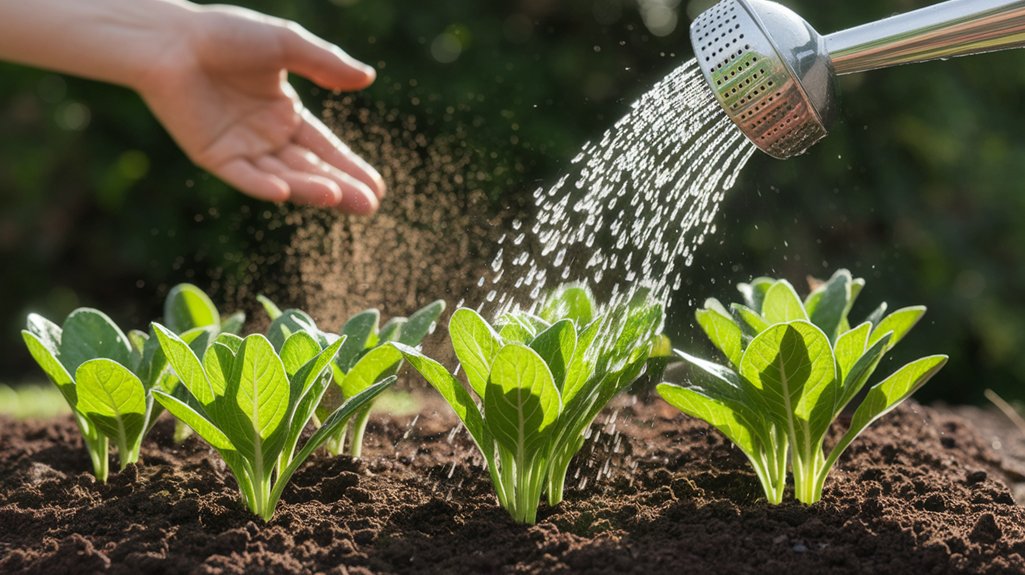
While ensuring your Spigarello plants thrive, understanding their watering and fertilizing needs is crucial. I’ve found that a careful approach helps to maximize growth and flavor. Here are my top tips:
- Watering Frequency: Keep the soil consistently moist but not soggy. I water them every 2-3 days, especially during dry spells.
- Fertilizer Type: Use a balanced, slow-release fertilizer. I prefer one with equal parts nitrogen, phosphorus, and potassium to support robust growth.
- Timing: Fertilize every 4-6 weeks during the growing season. I usually apply it in early spring to kickstart growth.
Managing Pests and Diseases
Although managing pests and diseases can feel overwhelming, I’ve discovered that a proactive approach makes a significant difference in keeping my Spigarello plants healthy.
First, I regularly inspect my plants for signs of aphids or cabbage worms, as early detection is crucial. I use neem oil as a natural pesticide, applying it bi-weekly during pest season.
Additionally, I practice crop rotation to prevent soil-borne diseases, which can devastate my crop. Maintaining proper airflow through adequate spacing also helps reduce fungal issues.
I’ve found that companion planting with marigolds deters some pests naturally. Lastly, I keep my garden clean by removing debris and dead leaves, which can harbor pests.
With these strategies, I’ve successfully minimized threats and enhanced my Spigarello’s vigor.
Harvesting Spigarello: When and How
When it comes to harvesting spigarello, timing is crucial for optimal flavor and texture.
I typically wait until the plants reach about 12 to 18 inches tall, which usually occurs around 60 to 90 days after sowing.
To ensure a clean cut and promote further growth, I use sharp shears to harvest the outer leaves, leaving the inner ones intact.
Ideal Harvest Time
Knowing the ideal harvest time for spigarello is crucial to ensuring you enjoy its peak flavor and tenderness.
I typically find that harvesting occurs when the plants are about 12 to 18 inches tall, usually around 60 days after planting.
Here are three key indicators I look for:
- Color: The leaves should be vibrant green, indicating optimal nutrient content.
- Texture: Leaves should be firm yet tender; they shouldn’t feel woody or overly mature.
- Size: Harvest before the flower buds open; this ensures you’re getting the sweetest flavor.
Proper Harvesting Techniques
To successfully harvest spigarello, I carefully assess the plants to ensure I’m using the right techniques for optimal results. I look for mature leaves that are vibrant green and firm, usually about 6-8 inches long.
Using sharp, clean scissors, I cut the stems just above a leaf node to encourage regrowth. It’s crucial to harvest in the morning when the moisture levels are high, as this preserves flavor and nutritional value.
I avoid taking more than one-third of the plant at a time, allowing it to recover and produce more shoots. After harvesting, I gently rinse the leaves to remove any dirt, then store them in a breathable bag in the fridge, ensuring they stay fresh for my culinary creations.
Culinary Uses for Spigarello
Although many may not be familiar with spigarello, I find its versatility in the kitchen truly remarkable. This leafy green not only adds a unique flavor but also enhances the nutritional profile of my dishes.
Here are three of my favorite culinary uses for spigarello:
- Sautéed with Garlic: I love quickly sautéing spigarello with garlic and olive oil; it creates a vibrant side dish that complements almost any protein.
- In Pasta: Incorporating spigarello into pasta dishes adds a nutritious twist. The leaves soften beautifully, infusing the dish with earthy flavors.
- In Salads: Fresh spigarello can also be used raw, providing a crunchy texture and a slightly peppery taste that livens up any salad.
Each of these methods showcases its unique attributes while delighting my taste buds!
Tips for Storing and Preserving Your Harvest
Once you’ve enjoyed the culinary delights of spigarello, it’s important to know how to properly store and preserve your harvest to maintain its freshness and flavor.
First, I recommend rinsing the spigarello under cool water and gently patting it dry. Then, wrap the leaves in a damp paper towel and place them in a breathable plastic bag. This method helps retain moisture while preventing excess condensation.
For longer storage, consider blanching the spigarello in boiling water for two minutes, then transferring it to an ice bath. After cooling, drain and freeze in airtight containers.
This way, you can enjoy the vibrant taste of spigarello in your dishes long after the harvest season has ended.
Frequently Asked Questions
Conclusion
In conclusion, sprouting spigarello can be a rewarding endeavor that enriches your garden and kitchen alike. By selecting the right seeds, preparing your soil, and managing the growing conditions carefully, you’ll ensure a bountiful harvest. Remember to watch for pests and diseases, and don’t hesitate to harvest at the right time for peak flavor. With a bit of practice and patience, you’ll enjoy the unique taste of spigarello in your culinary creations. Happy gardening!

